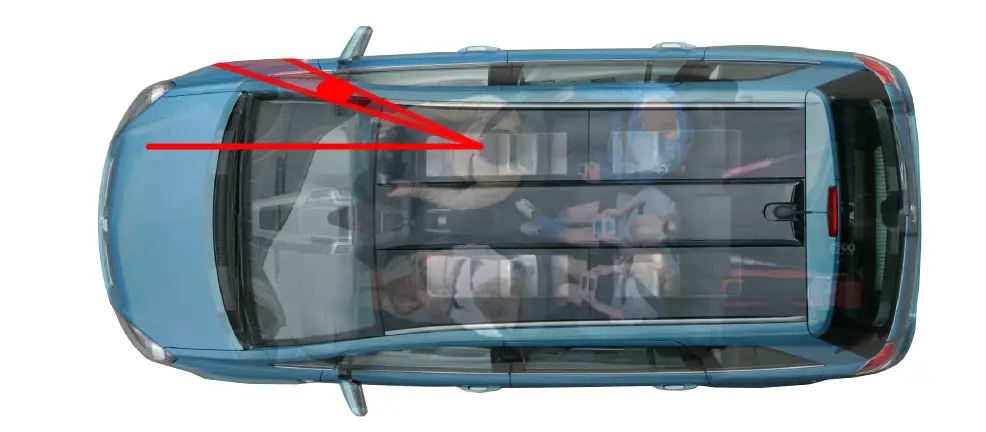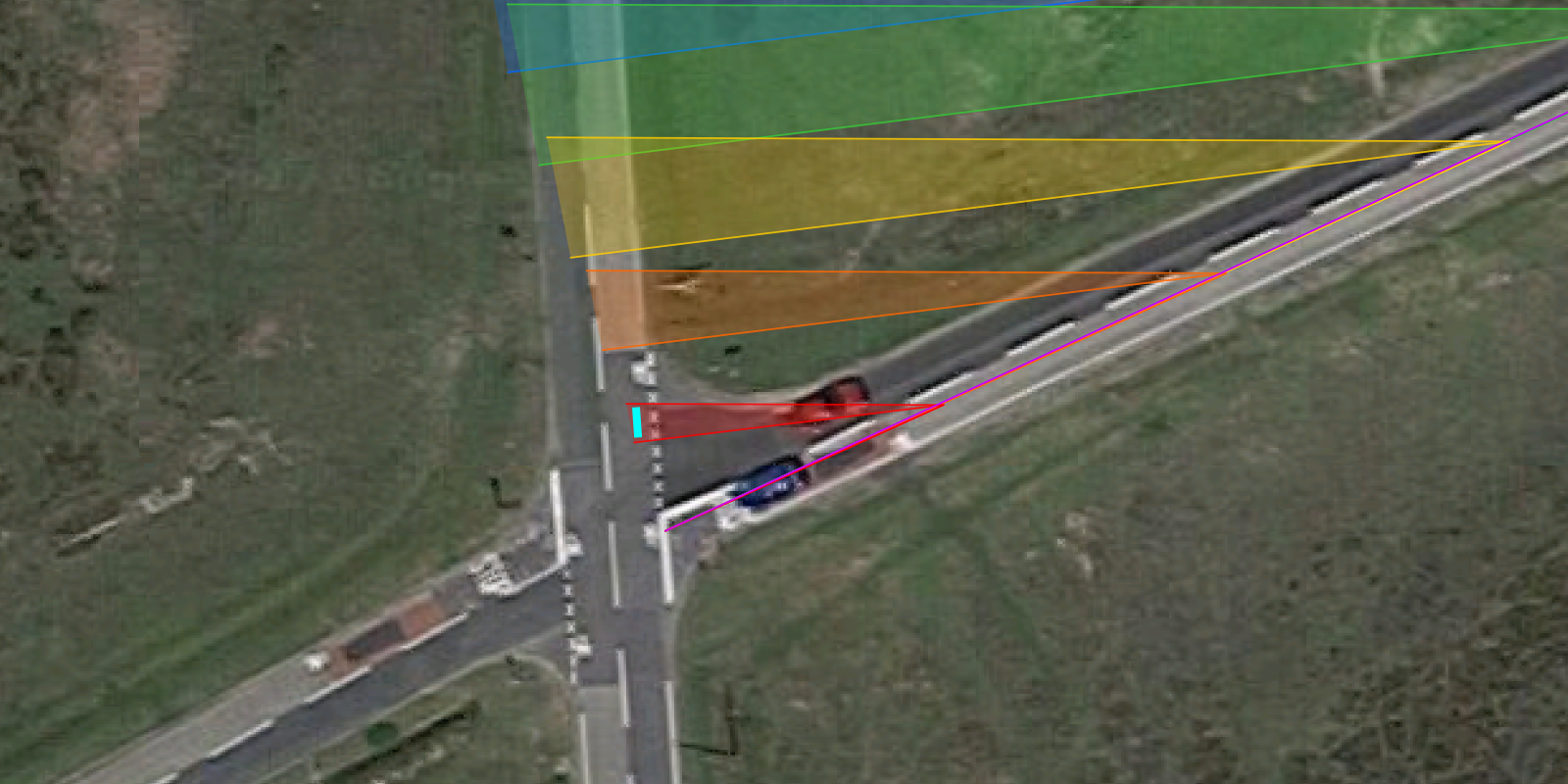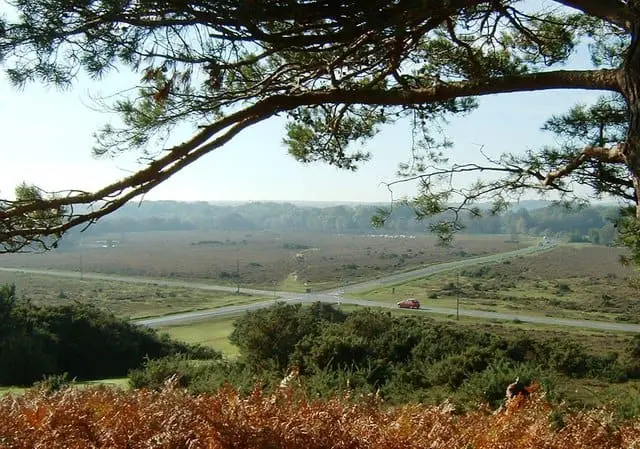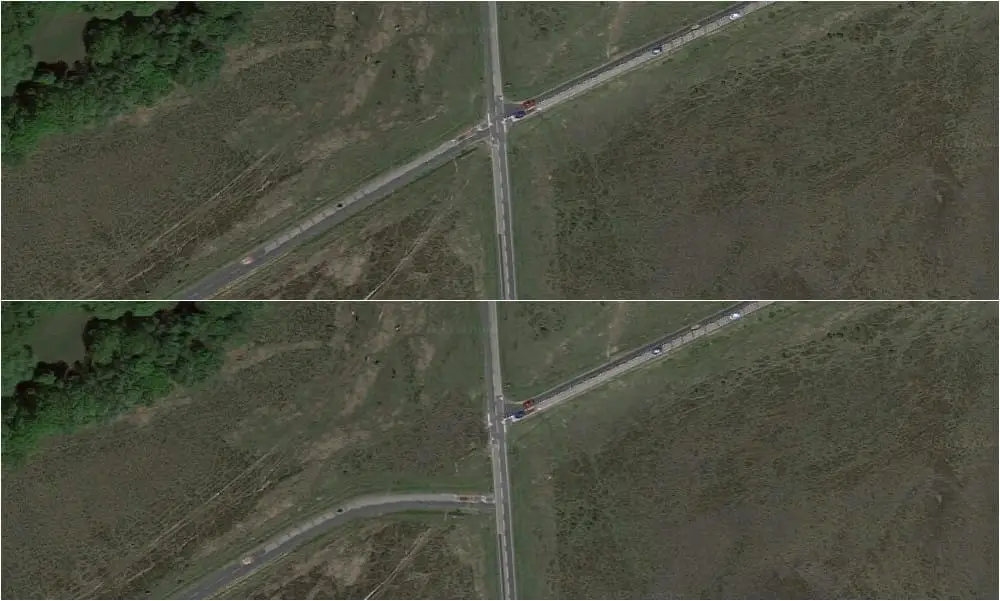We posted this opinion piece last week and as well as proving immensely popular, it also prompted so interesting comments and questions. The writer of the original piece, Bez, has prepared an addendum which seeks to address some of the points raised.
If you’ve already read the original story you can jump straight to Bez’s addendum here.
Ipley Cross is a largely unremarkable place, an open plain where two roads cross: Beaulieu Road running north-to-south and Dibden Bottom running roughly east-to-west.
Yet it is a place of notoriety. For good reason.
Ipley Cross Junction: Two Deaths And A Lucky Escape
In August 2011 a 15 year old boy was cycling along Beaulieu Road when he was struck from his left by a driver who failed to see him and failed to give way at the junction. The boy was sent flying, but somehow escaped with only a broken collarbone.
In May 2012 a second, almost identical incident occurred. Mark Brummell was cycling along Beaulieu Road when he was struck from his left by Stephen Chard, who failed to see Brummell and failed to give way at the junction. Brummell was killed.
In December 2016 a third, almost identical incident occurred. Kieran Dix was cycling along Beaulieu Road when he was struck from his left by Viral Parekh, who failed to see Dix and failed to give way at the junction. Dix, too, was fatally injured.
Chard was charged with causing death by careless driving and pleaded guilty; Parekh was charged with causing death by dangerous driving and pleaded guilty to causing death by careless driving, but was found not guilty of the more serious offence by a jury despite having driven through the junction’s “give way” line at 37mph without slowing.
Two questions present themselves.
Firstly, why it that the same collision keeps occurring at this junction? And secondly, why is such a standard of driving considered only to be “careless” rather than “dangerous”?
As we shall see, the answers to both are closely related.
By understanding one of the most likely causes for “failure to see” collisions at this junction, not only can we answer those questions but we can offer surprisingly straightforward solutions.
The Existing Layout at Ipley Cross Junction
Ipley crossroads has a very simple layout: two straight sections of road cross at an angle of 69 degrees, with the north-south road (Beaulieu Road) having priority.

Sight lines are good, although the rightward view from the easterly approach is affected somewhat by a gentle slope which rises to the northeast of the junction.
So, if it’s so easy to see, why is it apparently so easy to fail to see?
Hidden In Plain View
Far and away the most plausible answer is a phenomenon known as “constant bearing, decreasing range”, or CBDR. Originally noted by sailors, it is the phenomenon whereby two vessels, or vehicles, moving at steady speeds in straight lines towards a collision will maintain the same bearing.
If you’re a dab hand with basic trigonometry, you can probably figure the principles out for yourself, but if not then of course Wikipedia has an explanation.
CBDR is required knowledge in maritime and aviation, where ships and aircraft travel significant distances with constant speed and bearing, but it is rarely taught in the context of highways, where motion is generally less constant. But it is nonetheless important where two straight routes cross: not just two roads, but also where roads and railways cross at unsignalled level crossings (a design which is rarely if ever found in the UK but which is not uncommon in parts of the US).
Sailors and pilots are taught to detect ships and planes at a constant bearing and to take avoiding action. When it comes to drivers, however, things are very different, because almost all motor vehicles have a design flaw which means not only that a CBDR condition precedes a collision, but that unless (as we shall see) the driver does one of two things, the same condition means that the driver will never even see the phenomenon occurring.
That design flaw is the front ‘A’ pillar, at the edge of the windscreen.
The Pillar Shadow
Take a look at this plan view of a Vauxhall Zafira (as driven by Viral Parekh). When the driver looks towards the horizon, the front pillar will obscure some of the view. The red ellipse represents an approximate cross section at that point, with the shaded area beyond it being obscured as a result.

Once you extrapolate that obscured area, the extent of its effect is obvious. Here’s the same set of lines drawn on the Zafira, scaled up and overlaid on Ipley Cross.

At the position shown, approximately 100m from the Ipley Cross junction, the pillar obscures roughly 12m of Beaulieu road. That’s six bicycle lengths: enough to hide not just a cyclist but a small group of riders.
Of course, as the driver approaches that junction, that obscured section of road moves towards the junction with them. As does the cyclist.
Parekh’s car had a black box type device, which (contrary to his statements to police) recorded his approach to the junction at a steady speed of 37mph. At this speed it would have taken six seconds to cover the 100m to the collision, and the following image shows the approximate areas obscured by the Zafira’s pillar at six points in time representing each incremental second leading up to impact, with the red area showing the pillar shadow one second prior to impact.

Although the obscured section of road becomes smaller as the driver approaches, it remains large enough to completely obscure a bicycle until less than a second prior to impact: too late for either party to react.
The light blue line in the following diagram represents the approximate length of a bicycle and fits comfortably within the pillar shadow at one second before impact.

Naturally, as per the conditions of a collision course being signalled by a constant bearing, for any speed of the approaching car there is a speed at which a cyclist will remain obscured by the front pillar almost until the point of impact. The angles of the triangles define a ratio of speeds, and with this geometry that ratio is a little over 3:1.
So, in the case of a vehicle moving at 37mph westwards along Dibden Bottom, the CBDR speed southbound along Beaulieu Road is roughly 13.5mph. A very plausible speed for a cyclist.
But such a degree of coincidence is actually not required.
Due to the width of the pillar and the extent shadow it casts, which is much larger than a bicycle until impact is inevitable, true CBDR is not even necessary: it would be perfectly possible for a cyclist to be moving at around 17.5mph and then hit the brakes two seconds prior to impact, without ever appearing in the driver’s view.
There’s a whole range of steady speeds at which someone could approach this junction from the north and remain obscured to a driver approaching at a steady speed from the east (and, likewise, also from the south and east respectively).
Crucially, for any likely speed of an approaching car, any speed in that range is a perfectly feasible speed for a cyclist.
But there’s one more thing about Ipley Cross that makes it especially dangerous.
Critical Angles
Keen triangle enthusiasts may have started thinking about this already, but there are of course three angles to consider here.
The first is the angle between the two approach paths, which is a constant value defined by the road. At Ipley Cross this is 69 degrees.
The second is the angle between the driver’s line of travel and the line from their eyes to the front pillar. This will vary depending on the vehicle and the driver, but the approximations above put the angle at around 17 degrees to the centre of the pillar.
The third is the angle between the cyclist’s line of travel and the line from their eyes to the vehicle which will hit them.
At this location, with this vehicle, it is 94 degrees.
A car which is on a collision course at Ipley Cross with a cyclist who is obscured from the driver’s view by the front pillar will approach the cyclist from behind.
Ipley Cross is constructed in such a way that not only is it possible for a careless driver to drive straight into a cyclist without seeing them until a fraction of a second before impact, but under the exact same circumstances it is also possible for that cyclist not to see the car that hits them until the same moment.
If anyone were to take a highway engineer to a wide open space and ask them to design a junction which would readily enable two road users to collide with neither of them ever seeing each other, I doubt any would be able to manage it.
Yet this is precisely what exists.
The exact numbers, of course, depend on the driver’s height and seating position, the geometry of their vehicle, and—if you wanted to apply this to other locations—the angle at which the roads meet. The 3:1 speed ratio will vary slightly according to all these factors, and it will not always be the case that the deadly vehicle will be so hard for its victim to see, but the angle between a driver’s line of travel and the line between their eyes and the pillar will always be such that it is the slower road user who is at risk of not being seen.
The point is this: given the design of almost every motor vehicle on the road, the crossing of two straight roads can make for a perfect storm when combined with typical speeds of drivers and cyclists. Ipley Cross represents possibly the most perfect of such storms.
These collisions are, therefore, inevitable—aren’t they?
Of course not.
Join our mailing list to receive Singletrack editorial wisdom directly in your inbox.
Each newsletter is headed up by an exclusive editorial from our team and includes stories and news you don’t want to miss.
Human Error: The Eternal Excuse
“None of us are perfect drivers,” remarked Parekh’s defence barrister, attributing the whole affair to “human error”.
The human error in this case, and the other cases, may have been for the drivers to have maintained a constant speed (as we know Parekh did) without having physically moved their head either side of the pillar to rigorously scan the area ahead and to their right.
There are two very simple solutions to the very real risk of a driver-vs-cyclist CBDR collision.
Firstly, by slowing down significantly, any vehicle approaching from the right at a constant speed will move out of the obscured area and into view at the right of the windscreen.
And secondly, significant movement of the head will bring previously obscured sections of road into view.
It’s quite plausible that these simple strategies—either of them—could have prevented two fatalities at this one junction.
One of those strategies can, however, be easily enforced.
A Simple Solution
In 2015, nearly three years after the death of Mark Brummell, a local resident sent a pencil sketch to councillor David Harrison, which he passed on to Hampshire County Council. It was a simple plan of Ipley Cross, with one modification: the western approach now had a short kink at its meeting with Beaulieu Road, making the junction offset.

With this design, no longer would it be reasonably possible for any driver to simply blow through the junction. Drivers would have to come almost to a stop.
This design would, very simply, force the slowing down that eliminates the problem of CBDR.
The image above is, of course, a mock-up. The junction was never altered.
Two years after that simple sketch was handed to the authority responsible for the junction, Kieran Dix was dead.
Is This Not Dangerous?
And, lest we forget: what of the criminal proceedings against Parekh? Why is it not deemed “dangerous” to approach this junction at 37mph without slowing?
We must note that there are two parts to the definition of dangerous driving. Firstly the standard of driving must be “far below what would be expected of a competent and careful driver”, and secondly it must be “obvious to a competent and careful driver that driving in that way would be dangerous”.
People are often drawn to the term “far below”, which offers only a vague difference from “below” as used in the definition of careless driving, but generally the problematic clause is more likely the latter: it simply doesn’t matter how dangerous the driving is if it’s not obvious that it’s dangerous.
If we don’t teach people that to approach a junction at a constant speed is inherently dangerous, and if we don’t offer a basic explanation as to why, then it is surely not obvious to most people.
“Human error” may be real, but so are techniques to mitigate or eliminate its effects—and driver training is poor when it comes to equipping people with those techniques, let alone habituating them. (And let alone reviewing knowledge of those techniques every few years.)
It would appear from media reports that Parekh’s defence was simply that he did not see Dix; the implied logic being that since he saw no other vehicles he felt no compulsion to slow down. The jury’s acquittal equally implies that they agree with this logic: it was not obvious to them that failing to see another vehicle is anything other than unavoidable.
Yet, once the nature of a collision course is explained, the need to slow down becomes obvious.
The truly contemptible human error is not in a single person carelessly failing to see. It is in our failure to continually improve the training and licensing system so as to render the need to slow down obvious; it is in our incessant support of a system which cries “human error” as an excuse to do nothing, rather than as a stimulus to understand that error in order to create a solution.
Constant Bearing, Reducing Distance
So we can easily answer both of our original questions: why the same collision keeps occurring at this junction, and why driving straight through it at a steady 37mph is not deemed “dangerous” by law.
The question we still can’t answer is that of why, when clear solutions to both problems exist, no-one ever does anything about it.
We remain on the same bearing, heading for the next collision.
More road safety articles from Bez
Addendum
It is worth addressing a few points which have arisen in discussions resulting from the original article.
Let’s start with one which was fairly inevitable.
“These collisions are probably the cyclists’ fault.”
Yeah. There’s a reason why I don’t use Facebook. However, this remark is easy to dismiss. The police record “contributory factors” in their reports and, for the seven pedal cycle related collisions at this junction between 2005 and 2015 (which are the years for which I have contributory factor data) only one factor was attributed to a cyclist (in a slight injury collision) while ten were attributed to the drivers who collided with them.
In every single collision, “failed to look properly” was recorded against the driver. In the majority of collisions it was the only factor recorded.
It is very odd to assume the cyclist to be at fault when someone drives into them when they have clear priority. In terms of priority and duty of care it’s equivalent to someone walking across a zebra crossing and being hit. Now, if a cyclist were to ride into someone on a zebra crossing would you casually state that it was probably the pedestrian’s fault? Didn’t think so.
“We shouldn’t be fixing this junction just because some people can’t drive well enough, we should be taking bad drivers off the roads.”
The two are, of course, not mutually exclusive. But to use this as a reason to leave roads unchanged is deeply flawed. To detect someone driving across this junction without looking, it is necessary for someone else to be injured or killed: the way these crashes come about is by large numbers of people habitually driving in the same careless fashion, almost always with no consequence. You could drive through Ipley Cross dozens of times failing to look properly and never collide with anyone. Until the one time you do.
So a reactive process of taking away people’s driving licences in response has two problems: firstly it has a very low detection rate, and secondly it requires death and injury in order to work.
Certainly we should do a better pro-active job of training drivers about things like how to habitually deal with CBDR, pillar blind spots and other phenomena such as saccadic masking. And we should also reassess that training periodically rather than let people walk away from a driving test and never see them again. But there will always remain a large range of human imperfections—conscious and subconscious—which mean we do not behave perfectly all the time. Engineering is a way in which these imperfections can be prevented from causing harm.
So, on that matter of engineering, let’s review the alternative options which people raised.
“Converting the ‘give way’ to ‘stop’ would fix it.”
Absolutely not. As it happens, this is what Hampshire County Council did in 2017 (you may have noticed that the aerial photography on Google shows “stop” markings, while the older Streetview imagery shows “give way”, as was in place when both fatal collisions occurred).
Some people have suggested that a stop sign would, whilst not preventing collisions, at least provide greater culpability and mean that failing to stop would qualify as dangerous driving rather than merely careless driving. Sadly, they’re wrong. Take the examples of Russel Graham and Steven Conlan, both of whom killed when they violated stop signs and both of whom were charged only with causing death by careless driving.
I’ll return to the use of stop signs below, but first let’s review the other possibilities.
“Cycle lanes would help.”
The addition of cycle lanes does not address the described problem at all. What’s more, since it would require widening of the roads, it introduces us to a problem which is particular to the New Forest.
Not only is land loss in the forest is a highly sensitive issue, but the New Forest Verderers (who strongly oppose any land loss) have a unique legal powers. Any solution has to be meet their approval, and unfortunately this means that any solution involving loss of land is at an immediate disadvantage.
“What about speed bumps?”
Speed bumps are a reasonable idea in terms of being a low-cost intervention, but regulations permit their use only under street lighting, so they cannot be used here.
“Traffic lights would be better.”
Traffic lights are inappropriate at this junction for a number of reasons. At most times it is a lightly-trafficked junction and lights at this secluded location would thus invite abuse, especially given that the carriageway itself would still support passing through at speed.
The problem of the junction not being overlooked could be addressed with camera supervision, but this adds significant expense to an already costly change. Additionally, the intrusion on the land required by the installation of the lighting (which would require extensive works to provide electrical power from a considerable distance away) would meet strong objection. Fundamentally, lights would still not make it impossible to speed through the junction, and plenty of casualties are caused at light-controlled junctions by people wilfully or carelessly disobeying the signals.
“Obstructing people’s view would make them slow down.”
Another suggestion is the use of high fencing at either side of each approach to obstruct the sight lines, meaning drivers would be encouraged to slow down in order to check for anything approaching from either side. However, this also has a major intrusion on the environment (especially given the length of fencing which would likely be required—see the image below) and it adds its own dangers: is there a significant associated risk that drivers would look only briefly, perhaps if they had not seen anything enter the fenced section earlier in their approach, and fail to see narrow vehicles as a result?

“The Dutch would build a proper cycle roundabout.”
A roundabout would, if designed correctly, solve the problem of being able to pass through the junction without slowing (although roundabouts are not without their own issues). However, it would be hugely expensive and would have major impact on the land, and would meet extremely strong objection for both reasons.
The offset junction is an estimated £100k change (allowing for modifications to both east and west entry points in order to achieve perpendicular junctions in both cases) and involves a net land cost of practically zero. It achieves the aim of requiring drivers to slow down, and as such it forces behaviour which reduces the causes of casualties rather than optimistically relying on drivers’ compliance with signage.
The local authority’s response
Hampshire County Council’s response to the second death at this junction was to convert the signage from “give way” to “stop” and to modify the road surface.
They tweeted the news as follows:

This is an extremely weak intervention: it does not solve any of the problems documented above. This junction is not overlooked by anyone or anything, and the sort of driver who approaches such a junction with little inclination to slow down as a matter of caution is unlikely to be the sort of driver who behaves differently just because the sign has changed.
The carriageway itself still invites passing through at speed, and the disincentives to this are negligibly different. It is disappointing that Hampshire County Council considers this a worthwhile change: any rational view of human behaviour says otherwise, and those who use the junction agree. Repeatedly. (Or, if you prefer a video…)
This type of junction is a prime example of why paint is not engineering: it does not prevent anyone doing anything.
Hampshire County Council’s statement appears to be one of an authority in panic, trying desperately to do something with no clue as to whether it will work, and with no more clue as to what will.
But this neither a difficult nor a novel problem. Many other junctions in this country and others have already been converted to offset junctions. It is disturbing that a highway authority is “trialling” such an obviously ineffective approach to a well known and extremely serious problem while they “explore what can be done”.
The fact that Hampshire Council sign off with a promise to add more paint to the road surface is simply depressing: this is throwing good money after bad on an ill-considered response, undermining the estimated £100k budget required for a tried and tested solution.
The right answers are out there. It’s inexplicable that the local authority wants to “trial” such wrong ones.
- Smart Tires: Tyres From Space Coming Your Way Soon?
- Fresh Goods Friday 702 – The Quality Street Edition
- Bike Check: Jordy Scott’s Dual Slalom Hyper
- DEADLINE Midnight Tonight! Government Consults On Legalising Higher Powered Ebikes
- Bikes Bikes Bikes! The Show Bikes of Sea Otter

The topic ‘Updated: Ipley Cross | Why This Type Of Road Junction Will Keep Killing Cyclists’ is closed to new replies.